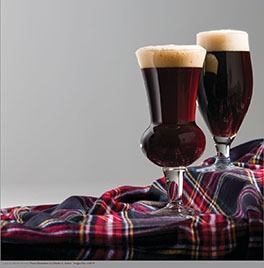Brew a Porter Using a Partial-Mash
Making a partial mash of base grains improves the flavor of extract beers. I’ll also show you how changes in some brewing procedures require compensating changes in other procedures. And of course, you’ll need a few new pieces of equipment — a bigger brew kettle to hold the entire volume of wort, a device to quickly chill your hot wort to pitching temperature, and an aquarium pump and aeration stone to add oxygen to the wort.
In Homebrew 301, we’ll focus on brewing a British style of beer — porter. Porters are dark, malty beers that first were brewed in London as early as the 18th century. Stout evolved from porters, and many porters have a slight bite from dark roasted grains, though not to the degree that stouts do. The hop bitterness in porters is well-balanced with the maltiness, with neither predominating in most examples of this style. Redhook’s Blackhook Porter and Sierra Nevada Porter are two excellent U.S. porters. Samuel Smith’s Taddy Porter is an English porter that is widely available in the States.
In this recipe, we’ll supplement the malt extract we use with sugars from a partial mash. In mashing, the starch in the center of malted grains is broken down into its constituent sugars. Along with the base grains, which will supply most of the fermentables from the partial mash, we’ll add some roasted specialty grains. We’ll also learn the advantages of boiling our entire wort, and the changes we’ll have to make in our equipment and brewing procedures as a consequence.
Partial mashing
In our porter recipe, approximately 2/3 of the fermentable sugars will come from malt extract. The remaining 1/3 will come from grains. Mashing is a simple process, but one that is often made to seem overly complex in some homebrewing texts. The essence of mashing is simply soaking crushed grains in water. As the grains soak, the water dissolves the starch in the grains. Enzymes from the grain attack the starch and chop it up into its building blocks, sugars. Once the starch is fully converted, the sugars are rinsed from the spent grains.
As far as starch-conversion goes, a partial mash works exactly like a full mash. However, since less grain is used in a partial mash, handling the soaking and rinsing of the grains is simpler and requires no special equipment beyond a mesh grain bag and a measuring cup. Performing a partial mash is very similar to steeping specialty grains. Gaining some experience with partial mashing often encourages brewers to go on to try making an all-grain beer.
Performing a partial mash
In a partial mash, you want to steep the grains in a volume of water sufficient to cover them completely, but not leave a lot of excess volume. For our porter we’ll steep 2 pounds of pale malt, plus the specialty grains, in 2 gallons of water. This is a thinner mash than most full mashes, but that won’t adversely affect our beer.
To begin the partial mash, gather the crushed grains and place them in the nylon bag. Although we will be holding the temperature of the mash at 150° F, we need to heat the water to 160° F to start. This is because the temperature of the mash will drop once the grains, which are at room temperature, are added to the liquid. Once the grain bag has been submerged for a couple minutes take the temperature of the water in the pot. As with the steeped specialty grains, you should shut the bag and tie it to the handles of your brew pot.
Try to hold the temperature as close to 150° F as possible for 1 hour. To adjust the temperature of the partial mash, add heat or cold water as necessary. When changing the temperature, add only a little bit of heat or cold water, then stir and retake the temperature. It’s easy to overshoot your temperature mark, especially when heating.
As you heat a pot, it takes time for the heat to travel through the metal and equilibrate. Thus, if you heat the mash continuously until the thermometer reads 150° F, then turn off the burner, the temperature will keep rising as heat from the pot is transferred to its contents. To avoid this, heat in short bursts, stir while heating, and wait a couple of minutes before checking the temperature again. It’s not going to hurt the beer if it takes you a little while to adjust the temperature, so be patient.
Rinsing the grains
After an hour, take a large kitchen strainer and lift the bag out of the water. Let the liquid drain into your pot. If possible, balance the strainer over the pot. If you can’t do this, have a friend hold it. Open the drawstring or untie the bag and expose the grains. Take a measuring cup and ladle water from the pot over the grains. The water will run through the grains and fall back into the pot. Keep doing this for 5 minutes or so. The idea here is to rinse as much of the sugars from the grains as possible.
Once you’re done rinsing the grains, use your small kitchen strainer to remove as much solid matter as feasible. Don’t spend more than 5 minutes doing this. Once the large solid materials have been removed, add the liquid (wort) to your large brew pot. (Before you do, give it a taste. Mmmm . . . malty!) Your strainers should be clean, but they do not need to be sterilized since the wort will be boiled after they are used.
Full-wort boil
In your large brewpot — it should hold at least eight gallons of liquid — combine the wort from the partial mash with water to make 5.5 gallons. Bring this to a boil, then add the malt extract. Although our target is 5 gallons of wort, we need more wort initially because some liquid will evaporate during the one-hour boil. The amount that evaporates is dependent on the amount of heat applied to the kettle. If you’re boiling on the kitchen stove, the evaporation may be minimal; if you’re using a propane burner, it may be considerable.
Boiling 5 gallons of wort is a large task for most home stoves. A gas stove can probably bring this volume of wort to a rolling boil. An electric stove may have problems developing more than a sustained simmer. Also, the amount of time it takes for the wort to come to a boil may be quite long. You may wish to begin heating the additional water while you are performing the partial mash. If your kitchen stove is having trouble boiling this volume, close the lid partially. Another option is to move your home brewery to the backyard and use a propane burner for the boil.
Two benefits of boiling the entire wort are increased hop utilization and less wort darkening compared to boiling a concentrated wort. When brewing a beer using a full-wort boil, you need to add fewer hops to get the same level of hop bitterness. This is because more hop bitterness is extracted in more dilute worts. With a full-wort boil, you can also brew beers that are much lighter in color than beers brewed with from a concentrated wort. In thicker worts, the sugars caramelize much easier, darkening the wort. This difference in color won’t be very visible in our porter, of course.
Another change that a full-wort boil will bring is the inability to pour the wort directly into the fermenter. (Pouring boiling wort into a glass carboy, for example, could crack the glass.) With no cold water to dilute the wort and bring down the temperature, you will need to cool the wort first. Then, given the large volume, it’s more convenient to simply siphon the wort to the fermenter.
This drawback, however, has a hidden benefit. Since siphoning the wort to a fermenter leaves behind material on the bottom of the kettle, you don’t need to keep your hops in a bag or tea ball. The hop debris will settle to the bottom of the kettle during cooling. The clear wort can then be siphoned off the hop material and hot break, the proteins, lipids and other compounds that coagulate in the boil.
Cooling your wort
There are several ways to cool wort. One way is to place the kettle in a sink or bathtub full of cold water and ice. The drawback of this method is that you need to lift a large volume of near-boiling hot liquid. Needless to say, this can be a bit dangerous. You can avoid the potential hazard of spilling 5 gallons of hot wort by chilling it on the stovetop with a submersible wort chiller.
A submersible wort chiller is a spiral of copper tubing. This tubing is submerged in the wort and cold water is run through it. Heat from the wort transfers to the cold water and is carried out. The speed of cooling and the eventual temperature the wort reaches depends on the temperature of the cooling water. You can speed chilling by gently whirlpooling the wort. If the submersible wort chiller is left undisturbed, the wort next to the copper coils will quickly cool. However, the wort farther away from the coils will cool much more slowly. The wort will move somewhat in that cold wort will sink and warmer wort will rise. But, starting a whirlpool will greatly enhance the amount of hot wort passing by the copper coils and greatly enhance your cooling rate.
If you move your submersible wort chiller in a circular motion, you will start the wort moving. As the wort moves by the cool chiller, it cools. Hot wort is prone to hot-side aeration, so try not to agitate it unduly. Induce a slow, steady swirling motion by moving the wort chiller in a circle. Repeat this motion every five minutes.
The wort chiller is usually sterilized by submersing it in the wort for the final 15 minutes of the boil. During this time, there is no water flowing through it. In fact, it’s best not to connect the tubing until after you have turned off the heat to the kettle. A logistical note: Connecting the tubing to your sink faucet will probably require an adapter, since most wort chillers are threaded to screw onto a garden hose connector.
Aerating the wort
Performing a full-wort boil necessitates one other change in your brewing procedure; you need to aerate your wort once it is cool. In Homebrew 101 and 201, we simply added cold, aerated water to our concentrated wort to aerate it. Now we can’t do that, because our wort is already at working strength. Adding water would dilute it.
One of the simplest ways to aerate cooled wort is by using an aeration stone attached to an aquarium pump. Most aeration “stones” used in brewing are actually made of stainless steel. Air is pumped into the stone, where it is forced out through hundreds of tiny holes. Air from the aquarium pump should be filtered, so you are not pumping airborne microorganisms into your wort. Most homebrew shops sell aeration kits that include the stone and a HEPA filter. Since the aeration stone and the tubing leading to it will touch the wort, you must sanitize both before you aerate.
You can aerate your wort while it is siphoning into your fermenter. Just put the aeration stone in the fermenter and run the aquarium pump as you are siphoning. By the time your fermenter is filled, the wort should have enough oxygen. If you’d like, you can run the pump for another five or ten minutes. However, keep an eye on the wort so the bubbles from the aeration stone don’t make the wort foam over.
Bottling the entire batch
After the porter ferments for a week or so in your primary fermenter, and then settles for another week in your secondary fermenter, it’s time to bottle. We’ll do things a bit differently this time. Instead of priming each bottle individually with PrimeTabs, we’ll use batch priming in a bottling bucket.
To bottle this way, you need to siphon your wort from your secondary fermenter into a sanitized bucket. Try to minimize the amount of splashing when you transfer the beer. You don’t want to oxidize the porter.
For 5 gallons of beer, use a sanitized spoon to stir a solution of sugar water into your beer. Make the sugar water by boiling 3/4 cup of corn sugar in 2 cups of water. Boil for 15 minutes, then cool the solution to about room temperature and stir it into the wort. Now, siphon the beer into bottles and cap them as before. The sugar water works just like the PrimeTabs; it provides a new source of fermentable sugar, which causes fermentation in the bottle and creates carbon dioxide.
After a week at room temperature, put the bottles in the fridge for a week. Then, invite some friends over and impress them with your newfound brewing skills.
Porter
OG 1.048 FG 1.014 IBUs 26
Ingredients
- 3.75 lbs. dried malt extract (light, unhopped)
- 2 lbs. pale ale malt
- 3/4 lb. crystal malt
- 1/2 lb. chocolate malt
- 1/4 lb. black patent malt
- 9 AAU Fuggles hops (2 oz. of 4.5% alpha acid) Wyeast 1968
- 3/4 cup corn sugar for priming
Step by Step
4 days before brew day
Make yeast starter and refrigerate.
3 days before brew day
Aerate starter
Pitch yeast to starter
On brewing day
- Heat 2 gallons of water to 160° F
- Steep all grains for 60 minutes
- Hold temperature at 150° F
- Rinse grains with hot water from brew pot
- Strain out “floaties”
- Add 3.5 gallons of water to mash water
- Bring the 5.5 gallons of water to a boil
- Stir in malt extract
- Bring wort to boil
- Add bittering hops
- Cool wort with wort chiller
- Siphon cooled wort to fermenter
- Aerate wort with aquarium pump, stone and filter
- Pitch yeast
- Ferment for one week
1 week after brew day
Rack beer to secondary
2 weeks after brew day
Test specific gravity with hydrometer for 3 days. Bottle beer when gravity is constant. Condition at room temperature for 1 week. Refrigerate for 1 week.
3 weeks after brew day
Beer is ready







